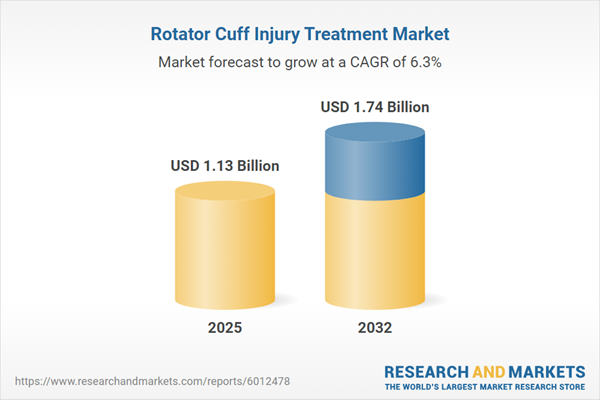Speak directly to the analyst to clarify any post sales queries you may have.
Senior decision-makers evaluating growth opportunities in the rotator cuff injury treatment market face a sector shaped by regulatory developments, advancing clinical practices, and evolving patient demands. This page condenses the critical insights required to support rapid, informed executive action in this dynamic environment.
Market Snapshot: Rotator Cuff Injury Treatment Market Trends and Growth
The rotator cuff injury treatment market is on a robust growth path, expanding in both size and CAGR. The trend toward minimally invasive technologies is redefining care standards and driving adoption across provider types. Business leaders are adapting their models to incorporate evolving global and local regulations, as well as responding to increasingly diverse healthcare needs in distinct geographic regions. As technology adoption advances and competitive landscapes shift, aligning strategies with the maturity of individual markets and patient profiles is now essential. Flexibility in operational management will continue to be crucial as patient care standards and reimbursement requirements evolve worldwide.
Scope & Segmentation: Strategic Dimensions for Executive Insight
This report provides a framework for navigating the complex rotator cuff injury treatment sector, helping executives optimize investments and operational alignment. It presents actionable segmentation and highlights the relevance of key trends to inform innovation and risk management:
- Product Types: Biologics such as platelet-rich plasma and stem cell therapies are enabling enhanced tissue repair and supporting improved rehabilitation processes. Orthopedic implants—anchors, plates, screws, and sutures—are driving accurate correction across patient scenarios. Surgical and diagnostic instruments expand procedural precision, with emphasis on less invasive settings. Pharmaceuticals like corticosteroids and NSAIDs remain central to pain management during recovery. Electrical stimulation and ultrasound devices are furthering patient rehabilitation and engagement through technology-enabled care models.
- Treatment Modalities: Surgical and non-surgical options—including pharmacological interventions, orthobiologics, rehabilitation, and both arthroscopic and open repair approaches—provide flexibility to address variable patient pathways and clinical scenarios.
- End Users: Hospitals, ambulatory surgical centers, orthopedic clinics, and rehabilitation facilities each play a unique role in therapy adoption, reimbursement dynamics, and patient throughput across healthcare systems.
- Distribution Channels: Hospital pharmacies, retail pharmacies, and online distributors are tasked with ensuring timely product delivery and adapting to transformative procurement and purchasing trends.
- Regions Covered: The report examines Americas, Europe, Middle East & Africa, and Asia-Pacific, specifically addressing major markets like the United States, China, Germany, India, Brazil, and Australia. Regional regulatory and demographic distinctions are highlighted to guide market entry and localization strategies.
- Key Companies Profiled: Arthrex, DePuy Synthes, Stryker, Zimmer Biomet Holdings, Smith & Nephew, B. Braun Melsungen, ConMed, Medacta International, Integra LifeSciences, and Wright Medical Group are actively developing innovations and enhancing competitiveness sector-wide.
Key Takeaways for Senior Decision-Makers
- Adoption of minimally invasive and regenerative approaches is growing, enhancing musculoskeletal outcomes and aiding objectives for patient satisfaction and shifts toward value-based care models.
- Artificial intelligence and telehealth platforms are improving diagnostic accuracy and supporting customizable care for expanding patient populations.
- Shifting global trade and regulations have prompted investments in robust supplier networks, strengthening supply chain resilience and adaptability to new compliance obligations.
- Broader portfolios of surgical and non-surgical solutions are improving access, allowing stakeholders to engage in wider population health initiatives and value creation.
- Differences in healthcare infrastructure and payer systems underscore the critical importance of market-specific, adaptable deployment strategies.
- Collaboration among device manufacturers, biotech firms, and digital health innovators is accelerating the integration of new technologies to scale outcomes across both mature and emerging markets.
Tariff Impact on Market Dynamics
Recent adjustments in United States tariff regulations have prompted senior leaders to scrutinize supply chain resilience. Prioritizing logistics capacity and supplier network stability is vital for maintaining efficient production and seamlessly adapting to ongoing compliance changes in the rotator cuff injury treatment market.
Methodology & Data Sources
This analysis consolidates clinical trial data, regulatory filings, intellectual property records, and financial reporting. Executive insights from leading medical and supply chain experts provide additional strategic context for actionable recommendations.
Why This Report Matters for Executive Strategy
- Offers segmentation and market intelligence to help leaders anticipate regulatory and operational shifts in the rotator cuff injury treatment market.
- Identifies technological advancements and partnership opportunities, enabling sustainable innovation and expansion in both established and developing regions.
- Supports decisions on resource allocation, investment priorities, and risk control to maintain momentum in a rapidly evolving market environment.
Conclusion
This report equips senior leaders with strategic intelligence and analytics needed to integrate technological advances, refine long-term planning, and capture growth opportunities across the advancing rotator cuff injury treatment landscape.
Additional Product Information:
- Purchase of this report includes 1 year online access with quarterly updates.
- This report can be updated on request. Please contact our Customer Experience team using the Ask a Question widget on our website.
Table of Contents
3. Executive Summary
4. Market Overview
7. Cumulative Impact of Artificial Intelligence 2025
Companies Mentioned
The companies profiled in this Rotator Cuff Injury Treatment market report include:- Arthrex, Inc.
- DePuy Synthes, Inc.
- Stryker Corporation
- Zimmer Biomet Holdings, Inc.
- Smith & Nephew PLC
- B. Braun Melsungen AG
- ConMed Corporation
- Medacta International SA
- Integra LifeSciences Holdings Corporation
- Wright Medical Group N.V.
Table Information
| Report Attribute | Details |
|---|---|
| No. of Pages | 193 |
| Published | November 2025 |
| Forecast Period | 2025 - 2032 |
| Estimated Market Value ( USD | $ 1.13 Billion |
| Forecasted Market Value ( USD | $ 1.74 Billion |
| Compound Annual Growth Rate | 6.2% |
| Regions Covered | Global |
| No. of Companies Mentioned | 11 |









